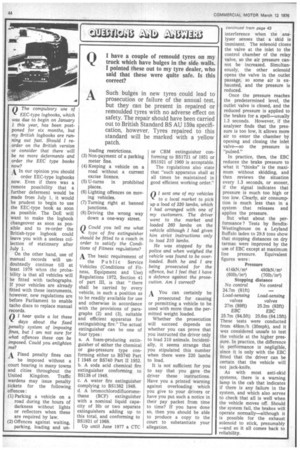loading restrictions.
Page 66

If you've noticed an error in this article please click here to report it so we can fix it.
(3) Non-payment of a parking meter fine.
(4) Keeping a vehicle on a road without a current excise licence.
(5)U-turns in prohibited places.
(6) Lighting offences on moving vehicles.
(7) Turning right at banned junctions.
(8) Driving the wrong way down a one-way street.
QCould you tell me what type of fire extinguisher should be fitted to a coach in order to satisfy the Conditions of Fitness regulations?
A The basic requirement of the Public Service Vehicles (Conditions of Fitness, Equipment and Use) Regulations 1972, Section 41 of part III, is that " there shall be carried by every vehicle, in such a position as to be readily available for use and otherwise in accordance with the provisions of paragraphs (2) and (3), suitable and efficient apparatus for extinguishing fire." The actual extinguisher can be one of four types: a. A foam-producing extinguisher of either the chemical or gas-pressure type conforming either to BS740 Part 11948 or BS740 Part 11 1952.
b. A soda acid chemical fire extinguisher conforming to BSI38 of 1948.
c. A water fire extinguisher complying to BS1382 1948.
d. A bromochlorodifluoromethane (BCF) extinguisher with a nominal liquid capacity of 31b or two separate extinguishers adding up to this total, and conforming to BS1921 of 1968.
Up until June 1977 a CTC or CBM extinguisher conforming to BS1721 of 1951 or BS1921 of 1960 is acceptable.
The regulations also state that "such apparatus shall at all times be maintained in good efficient working order."
















































































































